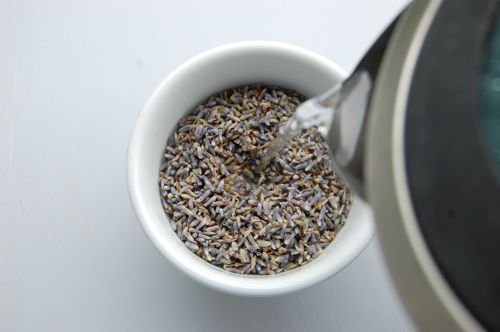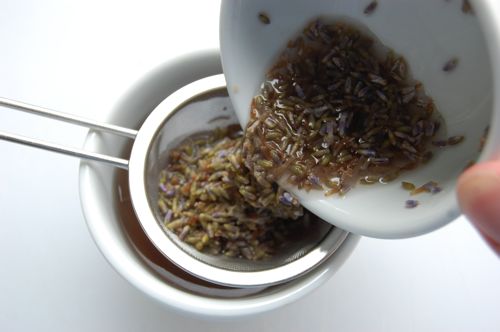How to Make Infusions
Infusions are highly useful things in the world of baking and sweets. If you’ve ever wondered how your local pastry shop gets the flavor of thyme into a tea bread icing, or how confectioners introduce the flavor of earl grey tea into a truffle, infusions are the answer. They allow a cook to import a flavor — usually one from an herb or spice — without having to import the herb or spice itself. That’s a very handy thing when you want an icing or a topping that’s free of flecks or lumps. Making an infusion is about as complicated as making tea. Here I’m making an easy lavender infusion.
I start with about two tablespoons of lavender blossoms, to which I add about a cup and a half of very hot (near boiling) water. I stir and allow the lavender to steep for 20 minutes…

…then strain.

And here I have a great lavender base to use in place of water in a simple powdered sugar-and-water icing:

It adds a nice perfume without being overpowering (and despite being purple-brown, adds virtually no color to the final mixture). Useful as a simple concoction like this is, you need not limit yourself to water. You can just as easily infuse milk, half-and-half or heavy cream (which can then be combined with chocolate to make a ganache). The applications are unlimited.
This is great! I just bought some lavender, and now I have a use for it! I’m thinking about making lavender macarons…can you infuse egg whites? Also, does the ingredient that you want infused need to be hot for this to work?
Hi Sheree!
There are other points to infuse a macaron, check the tutorial. But yes, you need some heat to really get the flavor out. Good luck and let me know how it goes!
– Joe
Hi Joe,
I have been experimenting with various infusions recently, mostly with vodka and various fruits and berries. I recently made some homemade Limoncello using Meyer lemon zest (from my Meyer lemon tree) and good Russian vodka (gift from a Russian friend). Oh my was that good! I wanted to see if I could replicate the taste using more readily-available ingredients so in one experiment I used store-bought lemon extract and added (American) vodka to it. As soon as I added the vodka, the whole thing turned from clear to cloudy. Why? And, is it possible to clarify it? The ingredients in the extract, according to the label, are: Alcohol, water, and lemon oil. Thank you for any insight you can provide.
Hi Karen!
Sorry to hear about that. The problem is that oil dissolves in alcohol. So now you’ve got lipids dispersed through the oil reflecting light, hence the cloudiness. As far as I know there’s no way to fix that, sadly. But I bet it still tastes good!
– Joe
Joe, Thank you for your response. If it’s a matter of the alcohol dissolving oil or dis-associating the lipids, then how could the extract, which contains alcohol, water, and lemon oil, have been clear to begin with?
Huh. That’s a darn good question, Karen. Let me see if I can get an answer from one of my lab buddies!
– Joe